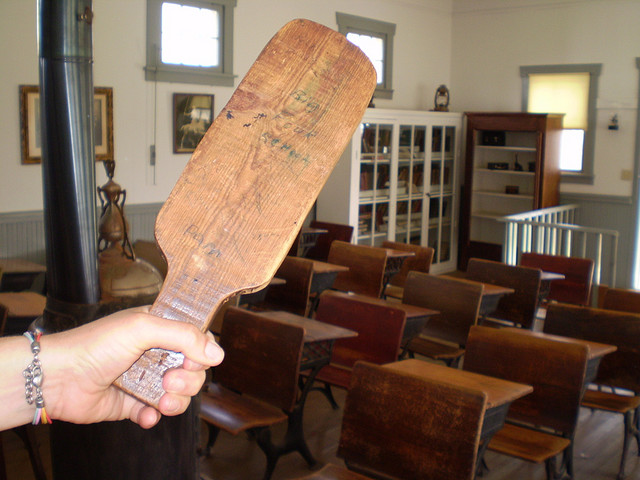 A recent YouTube video of a Texas judge beating his then 16-year-old daughter with a leather belt has reignited the debate over the effectiveness and morality of corporal punishment in the home.
A recent YouTube video of a Texas judge beating his then 16-year-old daughter with a leather belt has reignited the debate over the effectiveness and morality of corporal punishment in the home.
Judge William Adams, 51, contended he did nothing wrong and was simply punishing his daughter for stealing after the teen was caught downloading illegally distributed music from the internet.
Local police in Aransas, Texas have launched an investigation into the judges actions, but under state law -- provided the actions were administered in the interest of “reasonable punishment” – prosecutors may not have a statute to stand on.
Corporal punishment in the home had long been permissible under Texas law, and in 2005 state legislators took steps to strengthen those rights. House Bill 383 effectively set the standard for parental discipline as “reasonable punishment” and placed the burden of proof for abuse cases in the hands of the prosecutors. What exactly qualifies as reasonable punishment was not outlined in the bill.
In recent days, a rural Tennessee preacher came under fire after a copy of his book “To Train Up a Child” was found in the homes of three parents accused of beating their children to death on separate instances. The book, based largely on conservative Christian beliefs, advocates the use of a switch on a child as young as six months, along with other forms and best practices for physical discipline.
The preacher, Michael Pearl, 66, and his wife said unstable and abusive parents are to blame for taking the teachings out of context, and not the book itself. Neither has been charged in connection with the deaths, according to the New York Times.
Corporal punishment, or the act of discipline or punishment through physical force, has a long history in the United States. Since the times of the American Revolution corporal punishment, usually in the form of paddling or whipping, has been used in school discipline and criminal punishment.
Over time, incarceration gradually began to replace the use of flogging and other physical punishments for crimes, although some jurisdictions maintained “whipping laws” until the 1970s when it was barred nationally under the banner of cruel and unusual punishment.
While physical punishment was being outlawed against criminals in the 1970’s, the country didn’t see its first national case challenging the use of corporal punishment in schools until 1977. The U.S. Supreme Court deemed corporal punishment constitutional in schools by administrators and others acting as legal guardians. It is still maintained to this day.
Frustrated with the challenges of addressing the law in court, advocates working toward banning the practice turned to the political process to get results. Their work, coupled with a growing body of research that linked corporal punishment with behavior disorders such as increased anger, aggression and lower self-esteem, led to a slow, state-by-state decline in the use of corporal punishment in schools around the nation.
“It wasn’t that long ago in this society that it was allowed both culturally and legally for a man to hit his wife,” said Elizabeth Calvin, senior advocate for the Children’s Rights Division of Human Rights Watch. “And I think we’re at that point in our understanding of corporal punishment and its effects on kids.”

Nineteen states, in red, have laws permitting corporal punishment in school.
What’s more, minority and disabled students have disproportionately suffered physical discipline at the hands of administrators more than their white and abled counterparts, according to a 2009 joint Human Rights Watch (HRW) and American Civil Liberties Union (ACLU) report.
Today, fewer than 20 states have school “paddling” laws still on the books. During the 2005-2006 school year, 223,190 students suffered some sort of corporal punishment in school, representing a steady decline since at least 1980, according to the U.S. Department of Education’s Office of Civil Rights.
Broken down by state, those with the most paddling incidents tend to rank poorly in both educational improvement and student performance, according to a 2010 report by ACT.org, the organization that administrators the college exam.
In the home, however, corporal punishment remains largely unchallenged as a form of discipline. The exact definition of corporal punishment and the line between abuse and discipline varies by state, but many of the practices as old as our nation are still being used today -- and the public overwhelmingly approves. A 1999 survey, for example, found that 94 percent of parents reported spanking their children by the time they are four years old.
The definition of corporal punishment largely depends on the venue, with a legal distinction drawn between criminal, educational and in-home settings.
“Dividing it up in those three separate categories overlooks the essence,” Calvin said, “which is that we shouldn’t be hitting our kids. The act of physical force sends a message we shouldn’t be sending in any setting.”
Photo credit: Wesley Fryer/Flickr


that wanker is a chil abusing power hungry fool, he couldnt just give her one or two lashes he had to continually beat her, his wife was obviously scared of him and followed through she was begging for them to stop and he didn’t judge or not he should be tried and prosecuted !! I am fuming and feel physically sick !!!
In light of Judge Adams video,
Ask ten unyielding proponents of child/adolescent/teenage-only “spanking” about the “right” way to do it, and what would be abusive, indecent, or obscene, and you will get ten different answers.
These proponents should consider making their own video-recording of the “right way” to do it.
Visit Unlimited Justice or Parents and Teachers Against Violence in Education to learn more and add your voice.
Corporal punishment of children should be ended through both education and legal reform. Over l00 countries ban school corporal punishment and 31 ban it in all settings including homes. If the CDC and other federal health entities took on spanking children the way it took on smoking, it could face the fate of smoking….it might still exist but it would be seen as unhealthy, unsafe, and undesirable. In a small way, the Center for Effective Discipline has influenced thousands of parents with its observance SpankOut Day April 30th with hundreds of small grants for informational programs for parents on effects of corporal punishment and alternatives. Guidelines are now available on their website. Education is important and should go hand-in-hand with legislative efforts banning corporal punishment of children and protecting children in homes.
I am wondering how Ms. Calvin envisions the enforcement of laws that ban corporal punishment in the home, or is she perhaps in favor of educating parents?